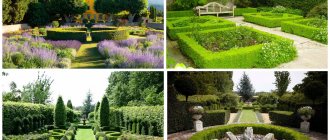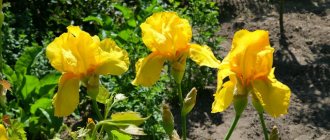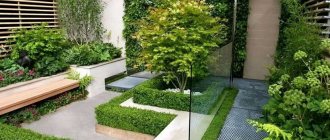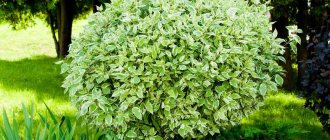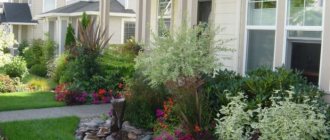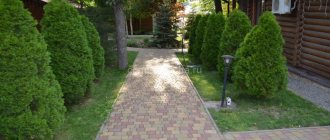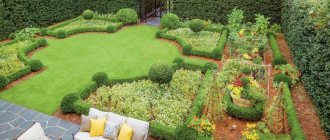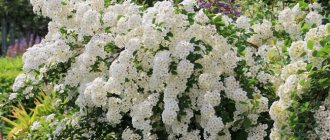Landscape styles
Anastasia Zemlyanichko 06/05/2018 no comments
1
( 17 ratings, average: 4.26 out of 5)
- 1 Moorish style and its classical canons 1.1 Strict adherence to the laws of geometry
- 1.2 The sacredness of water
- 1.3 Patio
Since ancient times, the oasis has been the most heavenly spot on earth for every person who, by the will of fate, found himself in a desert area. And an ennobled oasis is the dream of every sultan. And how sometimes you want to feel like that very sultan, to be in the garden and enjoy not only the lush shade of the trees, but also the beauty of sparkling fountains and smoothly flowing streams.
It is worth noting that Moorish-style gardens, which can be seen today in some estates, are direct descendants of the gardens of the Ancient East, which even today captivate us with their beauty and sophistication. One of the striking examples of such a luxurious corner of nature is the Hanging Gardens of Babylon, which are described in the Koran and have been considered one of the wonders of the world for many years.
A LITTLE HISTORY
Once upon a time, many centuries ago, the Moors owned part of Spain. The village lawn owes its appearance to them. Travelers who first set foot in the city of Cordoba - the center of Moorish art, culture and science - were amazed by the beauty of this mysterious city.
Everything here was unusual, but the gardens were especially beautiful, where among the fountains and ponds, alluring with their amazing beauty and coolness, under the canopy of trees and on the edges, bright, fragrant wildflowers were sown, attracting butterflies and bees. Europeans adopted an unusual experience for them - planting simple wild flowers and herbs in their well-kept and austere gardens.
This is how flower lawns began to appear, which were called Moorish lawns.
In our country, the Moorish lawn, or Moorish meadow, is not so often used in landscape design - and quite in vain, but it is also convenient because it does not require fertile soil. And not everyone knows that this is not just a mixture of lawn grass and annual and perennial flowers and grasses. After all, you can make it yourself to your liking, even without lawn grass, from only annual or perennial flowers with the addition of bulbous ones. The main thing is to form the composition of the seeds, combining plants of different flowering periods in such a way that the lawn will delight you from spring to autumn. Such a mixture can include 30 - 40 species, and it is also better to select seeds for planting that are appropriate for your region.
History of style
Not a single landscape style can be reproduced without studying at least a little the history of its formation, without being imbued with the national philosophy and way of life.
Modern Moorish garden design owes its origins to the culture of the Middle East. Its brightest example today is considered to be the gardens of the Alhambra in Southern Spain, where Arab culture took root for a long time along with the Islamic conquerors. Bearing imprints of Muslim teachings, Moorish gardens were created as a semblance of ancient oases, personifying the long-awaited refuge of exhausted travelers. Here, as in the Garden of Eden, which the Koran promises as a reward for the faithful, one could find serene tranquility, enjoying the coolness, the murmur of water, the taste of juicy fruits, the aromas of unusual flowers and the singing of birds.
Plants in Moorish style
Plants for the Moorish garden are selected to create the feeling of a Garden of Eden. Bright colors, the dominance of flowers and pure greenery of trees and bushes, vines and fruit trees fill such gardens with life, color and harmony.
One of the most popular objects of the Muslim garden is the rose garden. Fragrant and luxurious, it offers a tribute to the garden princess by selecting the most brightly colored and fragrant varieties. You can frame fountains and ponds with a rose garden, or you can lay them out like flower beds, emphasizing the beauty and luxury of plants with bright accessories. Roses can also be planted individually, using as many of them as possible.
Carpet flower beds and mixborders, elaborate arabesques and parterres allow you to fill the squares with patterns and imitate the effect of oriental carpets with the help of perennial and annual plants.
When selecting plants, it is important to consider several important criteria:
- creating a flowering relay, combining plants with different flowering periods for the effect of constantly present colors;
- selection of the brightest and purest, “absolute” colors;
- priority in choice for classical cultures.
In Muslim gardens, carnations, poppies, cornflowers, chrysanthemums, peonies, irises, lilies, daylilies, and all types of carpet perennials look great. In such a project, you can introduce any number of bright bulbous accents - from tulips to crocuses and other primroses. Spicy herbs and aromatic plants of all sizes and shapes are more than appropriate, as are bright summer flowers - from fragrant tobacco to ageratum, gypsophila, lavatera, lobelia, petunias, which allow you to play with textures no worse than with colors.
According to historical traditions, flower beds in a Muslim garden are arranged in a pattern, allowing plants to develop freely. But today, the lack of architectural solutions or an abundance of detail in mosaics and water features is sometimes compensated for by high trimmed borders, including ornamental motifs of green frames in the line.
Trees with a strict crown are inappropriate here. This is a garden for free growing plants. Purely decorative species are less popular than fruit trees. Enjoying your fruit harvest straight from the branches is a luxury that immediately changes the atmosphere. Apple trees, cherries, sweet cherries, apricots, plums - you can choose fruit plants to suit your taste.
Beautifully flowering shrubs, placed singly, are selected from among the most lushly flowered classics. In addition to roses, mock oranges and hydrangeas, spirea, quince, and rose hips are appropriate. Flowering or deciduous vines, from roses to clematis, actinidia and grapes on pointed arches, obelisks and walls are also always appropriate in this style.
Tropical and subtropical plants that have become a symbol of the Muslim garden - pomegranates, palm trees, citrus fruits, laurels and many other plants - are introduced into the design in the form of tubs, placed in those places that lack expressive accents.
Features in landscape design
The classic features of the direction are: a reservoir in the center of the territory and four springs emerging from it. An alternative is four paths leading from the water feature, which is very symbolic for Islam. Four elements zone the site, dividing it into equal parts. Water should not go out of sight, periodically sparkling between lush flowers and plants. On a large garden area, each of the four zones is also divided into four parts. This number is illuminated, in the Moorish style there is a lot associated with it.
The murmur of water, the fragrance of herbs, and the pleasant coolness in the shade make the garden with oriental motifs a favorite place for leisure and relaxation for the whole family. It is a place where important events are joyfully celebrated and family and friends are invited. The arrangement of the site should be lush, luxurious and bright. The specific layout (dividing the territory into 4 parts) represents associations with the four natural elements - water, air, earth and fire. The lines of their division may be barely noticeable (narrow streams, garden paths), but the design of all parts is strikingly different from each other.
Mauritania is a country with a hot sun, from which it is difficult to escape in the scorching heat. For this, people used fabric curtains. In a country with a temperate climate, this element is more decorative than functional. But it is mandatory in this style direction. On the site you can create a pavilion, gazebo or outdoor dining area. They are covered with a spacious tent, preferably with a domed roof. It is better to choose a light, flowing fabric made from natural materials. Oriental colors with shiny patterns on a calm background will add special color.
Structure and main elements of a Muslim garden
All Muslim gardens are built on squares. Even if a large rectangular or irregularly shaped area is decorated in this style, the site is divided into separate square zones, following one after another, or a genuine Moorish garden is designed only in the square zone closest to the house, and the rest of the territory is decorated using other styles.
Arrangement of a Muslim garden always begins with paths and zoning. Thanks to them, the principle of four gardens, or chor-bagh, is put into practice - the symbolic embodiment in garden design of the four sacred rivers that flow from the Garden of Eden and divide it into equal parts.
At the intersection of the paths there is the semantic and geographical center of the Moorish garden, the design of which is always given special attention. The square section of the garden determines its strict geometric structure, which does not change even in the original modern interpretation of the oriental style
Each individual secondary square in a Muslim garden, if size permits, can be divided into four more squares. In turn, in each “unit” you can introduce a central water element or an object of small architecture, endlessly playing with squares and their variations. Arteries or paths can also be laid diagonally if the size of the garden allows you to play with symmetry in complex patterns.
Paths in a Muslim garden are always completed with a striking architectural element. An arch, green tunnel, decorative gate or false doors and gates should mark the end of each path and create a visual point of “fixation” of its length, completing the perspective.
The central part of the garden and each individual square is the most important design element. In the very geographic center of the square plot, a water feature is created or a recreation area is created, which will become the semantic center of the entire project.
Popular articles Types of lawn seeders: how to make a seeder with your own hands
The most popular design option for the central part is an expanded paved area into which a fountain, pool or decorative pond with a fountain is inscribed. A square or round pond copes with this task perfectly. But there are also alternative solutions - from a pavilion or gazebo with lines that appeal to Arabic motifs to placing a rose garden.
Fountains and ponds of strict lines are a must in Muslim-style gardens. Jearld Moldenhauer
Features of composition and zoning
The Moorish garden is good because it can be arranged in a very small area. Inner courtyards - patios - are especially often reserved for them. The landscape of the site is of great importance - it must be flat.
The center of the composition is always a body of water. A fountain can act as a self-sufficient reservoir, from which planning will be carried out. If space allows, the central zone can be expanded indefinitely. The fountain can be placed in the center of a stone bowl, which in turn will be located in a pool of strict geometric contours; four water channels can be drawn from it at right angles or four main paths can be laid.
The number four is not mentioned by chance - it symbolizes the four rivers of paradise. In large gardens, the four zones formed by canals can again be divided by canals or paths, only at right angles and only by four - maintaining geometric accuracy when planning is very important.
Another feature of the compositional solution of this direction of ethnic design is absolute symmetry. However, it is smoothed out and hidden by lushly flowering vegetation, thanks to which the clear lines of the garden seem soft and blurred.
landscaping
Designing and creating a Moorish garden project allows you to use a variety of bushes, trees and herbs, without which it is difficult to imagine a real paradise. A water source makes it possible to improve the area with a large number of plants. In addition, the traditional Arab house is covered with white plaster. Now imagine how a lush carpet of plants and herbs in rich colors looks against this background.
Before planning horizontal gardening, the landscape designer studies the soil characteristics and topography of the site. The Moorish style requires the creation of a flat surface. After this, flowers and shrubs are planted. The vertical lines in the garden are determined by the trees. They are characterized by lush crowns in the shape of a ball or pyramid. The bounty of nature is invariably associated with fruit. Therefore, cherries, pears and apple trees are planted in the Moorish garden. Lemons and oranges, ficus and palm trees are appropriate in the landscape. They are planted in large flowerpots, which are removed indoors during the cold season.
Sun protection
The hot climate prevailing in the historical homeland of the style leaves people no choice, forcing them to come up with ways to protect themselves from the heat. In the Moorish garden they use:
- Gazebos and galleries. Maximum open. Mostly white. With lancet windows and a traditional domed roof. They are always equipped with stylish and comfortable garden furniture, complemented by a variety of ottomans and pillows. Draperies made of flowing fabrics and oriental lamps are used as decor.
- Canopies. They are usually made in the form of a pergola entwined with flowering vines. In the shade of such a natural shelter, marble or wooden benches with intricate patterns are traditionally installed, conducive to a pleasant rest surrounded by nature.
- Tents. They are usually located in open areas. They are made from lightweight translucent fabrics that do not interfere with air circulation. They have a domed roof. Inside such structures there can be low garden sofas, complemented by colored pillows, and tables for desserts.
Moorish style
A Moorish-style garden plot is a place of calm and relaxation, peace and serenity. The splashes of water in the fountain sparkling in the rays of the sun, the fragrance and varied palette of colors of numerous flowering plants, decorative elements - all this turns an ordinary garden into a Moorish fairy tale. In it you forget about all the hardships and troubles, about household problems and worries, and worries and anxieties simply disappear. Here you feel like you are plunging into another world, into another life.
The main and central element of this style is a pond, from which there are paths decorated with stones and tiles in white or yellow. Most of the garden area is covered with perennial brightly flowering herbaceous plants and shrubs that bloom one after another throughout the warm season. Plants with different flowering periods create a feeling of constant celebration, which is fueled by their varied aroma.
The walls of buildings and fences in the garden area are decorated with plants with colorful flowers creeping along them. A Moorish garden will certainly have a fountain, a swimming pool, a rose garden and, as a special decoration, a mosaic. It is used to design the boundaries of ponds and most paths. The color scheme consists of soft and restrained tones and midtones, as well as several soft shades. The rose garden and the pool are two inseparable elements of this style. Specially selected varieties of roses with attractive colors and fragrant aroma are planted near a pool raised above the garden level. The finishing touch to this fabulous relaxation spot will be the sofas placed throughout the garden area.
Fencing
From ancient times to this day, privacy has been considered an integral feature of the Moorish garden. That is why the fence should be as reliable as possible, causing a feeling of security and complete isolation from the outside world.
Symbolic borders made of neatly trimmed bushes are used as internal fences.
The back terrace of the house usually serves as the entrance group. At the same time, it is important that the design of the terrace matches the concepts of the chosen landscape style as much as possible.
Moorish lawn care
The main stages of caring for such a lawn are:
- Watering.
- Piercing to aerate the roots.
- Rare mowing.
- Feeding as needed.
The Moorish lawn needs regular watering.
Watering is especially important during the period of emergence and the beginning of plant growth. It is necessary to irrigate carefully using the drip irrigation method. Small seeds are easily washed away; this should not be allowed. When the plants become stronger, depending on their specific species and weather conditions, water less frequently, usually once a week is enough.
To form a branched root system capable of independently extracting moisture from the lower layers of the soil, it is necessary to provide aeration. The lawn cannot be loosened, so the piercing method is used. You can use regular pitchforks for this. Fertilizing should be done only as needed
Particular care should be taken when applying nitrogen fertilizers, which stimulate active growth of green mass, sometimes to the detriment of flowering.
Mowing Moorish lawns must be treated with due care. Mow the first time after the grass reaches a height of about 10 cm and the flowers have not yet appeared.
This is important so that previously sprouted and strengthened cereals do not interfere with the appearance of inflorescences. In some cases, mowing mid-season may be necessary.
The last time is mowed in the fall, after the end of the growing season, to a height of 8-12 cm.
The Moorish lawn has the unique charm of natural grasses. It not only blooms beautifully and brightly, but also exudes a wonderful aroma. And simple care makes this garden design even more attractive. Using our tips, you will definitely be able to grow a flowering lawn with your own hands.
Rules for creating a Moorish garden
Currently, the creation of a Moorish garden has become the main and very popular trend in landscape design. And a corner of your site, made in this style, requires its own special philosophy, despite the fact that there are no strict requirements for a basic garden, some rules are still worth adhering to:
- geometry and division into zones;
- mandatory availability of a water source;
- careful selection and combination of plants;
- paved paths.
It is worth remembering that Moorish gardens are quite small in size. But given the fact that in our latitudes there are no interruptions in water supply, it is possible to allocate a much larger area for it than is required:
- in the country house and in the garden;
- on a personal plot;
- in the courtyard of a residential building.
All these places will be a wonderful place to create such a piece of paradise. A courtyard near your house, decorated in a Moorish style, will look especially good.
And the main thing to remember is that a landscape in the Moorish style should evoke only positive emotions, allowing you to relax and unwind your soul and body to the gentle murmur of fountains and the aromas of herbs and flowers. And remember that there are no strict requirements for the terrain being designed, but it is still desirable that it be as flat as possible. And small buildings will only decorate the garden even more, allowing you to allocate places for relaxation and reading. Not a single friend who comes to visit you will be able to refuse to visit such a paradise of nature on your site. And you will rightfully have something to be proud of!
Popular articles Disease prevention and pest control of gladioli
Moorish style in landscape design
Features of landscaping rules
The presence of an open reservoir in the Moorish garden allows even the most fastidious plants to feel comfortable . The bushes and trees in such a garden are trimmed only as needed, otherwise they grow freely, filling all the free space between paths and ponds.
The main decoration of the Moorish garden will be a luxurious rose garden. And when creating it, you should choose roses very carefully, giving preference not to those that look beautiful, but to those that will smell luxuriously, creating a unique ensemble of aromas in this corner of paradise.
Springs and reservoirs should be decorated with luxurious water lilies, which will give them even more tenderness and charm.
Pomegranate and fig trees have always been considered symbols of the Moorish garden. They are planted at the entrance to gardens and along paths, as well as along the entire perimeter of areas. As an alternative, you can use magnolias, peaches or almonds, which are in no way inferior in beauty and luxury to exotics, but tolerate the climate of mid-latitudes much more easily. Cherries, apple trees and apricots can serve as vertical landmarks.
When designing a Moorish garden, give preference to those trees that have a spherical or pyramidal crown shape. But we shouldn’t forget about flowers. So, poppies, daffodils, crocuses and lilies are perfect for garden landscaping. Landscape design in this case should be created in such a way as to provide a constant carpet of flowers throughout the year. Spicy herbs, which have always been grown in such paradises, will fit perfectly into such a landscape design.
Wildflowers will also be a true decoration of such a corner of nature a landscape designer, especially a professional one, will be able to organically fit them into the overall style of the garden and create a true corner of heaven on earth. And if you consider that most plants attract many butterflies and bees during the flowering period, then an oriental flavor is guaranteed to your site.
Use of plants and decorative items
Flowers and lush plants are an important element in Moorish decoration. A riot of colors, colorful and fragrant crops delight with their presence almost all year round. Preference is given to large and unpretentious representatives. The permanent “inhabitants” of the gardens of the East are herbs. They have a special place. With their lightness, suppleness and pleasant aromas, they personify the feminine principle.
Comfort, coziness and luxury of the Moorish style in the garden are embodied by soft armchairs and sofas under a fabric tent, decorated with many pillows. Garden furniture in the patio and in all parts of the garden is abundant: benches in marble, wood and wrought iron.
Statues and images of humans and animals are not permitted due to religious traditions. They are replaced by decorative shrubs, flower arches, and flower beds. Pergolas and wooden nets, marking the transitions from one part of the garden to another, are entwined with weaving plants. The latter not only green the area, but also provide the desired shade and coolness. A gate to an area with a semicircular arch or vaulted niche.
Thanks to protection from drafts and scorching rays of the sun, the most demanding and capricious representatives of the flora can grow in the garden. And the humidity from the reservoir has a beneficial effect on their growth and decorativeness. They fill almost all available space and are rarely cut. Naturalness is a priority.
As true connoisseurs of luxury, Muslims adore roses of all types and varieties. A luxurious rose garden always occupies a central place in the garden. The ensemble is created from blooming beauties with a delicate aroma and a long flowering period. Delicate buds turn the garden into a real paradise. They often decorate springs and ponds, adjacent to water lilies and climbing plants. Symbolic plants are pomegranate and fig. The cold climate does not allow these crops to be grown in the ground, so they are planted in flowerpots and brought indoors during the cold season.
Plants for the Moorish lawn: buy or make a mixture yourself?
On sale you can find ready-made lawn mixtures with flowering herbs. They can be called differently - Moorish mixture, Alpine, flowering, etc. They are usually 70-90% cereals and herbs, with the remaining 10-30% flowers.
But you can create a mixture for such a lawn yourself. The easiest way is to take lawn grass as a base and mix in the seeds of any flowers that you want to admire on your site.
To ensure that the lawn looks exactly like a lawn, and not a flowerbed or a purely green playing field, maintain the proportions between flowers and herbs (they should be the same as in store-bought mixtures).
Popular options for Moorish lawn
Select the composition of the mixture carefully, because it determines how the lawn will look, as well as the duration of flowering. The following lawn options are popular:
- high, i.e. consisting of tall plants, incl. cereals;
- low, based on low-growing herbs and flowers;
- monochromatic, with flowering plants of the same color;
- variegated - the brightest lawns with a variety of cereals and flowering plants of different colors and shades.
Even if you want to create a one-color lawn, select plants with different flowering periods for it. Otherwise, the Moorish lawn will quickly lose its decorative effect and take on the appearance of an unkempt area.
Choosing plants for a Moorish lawn
When choosing plants for a Moorish lawn, do not forget that this is still a lawn, not a flower bed. Therefore, its main area should be occupied by cereals and herbs. Plus, the more flowers there are, the more difficult it is to maintain an herb garden. The following types of grass behave well in mid-latitudes:
- wheatgrass;
- fragrant bison;
- lagurus;
- meadow bluegrass;
- perennial ryegrass;
- timothy grass;
- red fescue;
- bentgrass
An important rule for mixing is to choose plants that thrive in each other's company. However, without flowers, the lawn will lose its decorative value.
Therefore, dilute the herbs with your favorite annuals and perennials, as well as early flowering bulbs
However, without flowers, the lawn will lose its decorative value. Therefore, dilute the herbs with your favorite annuals and perennials, as well as early-flowering bulbs.
| Flowers for the Moorish lawn | ||
| Bulbous (early flowering) | Annuals | Perennials |
|
|
|
Let us once again remind you of the importance of choosing flowers taking into account their flowering time. The spring brightness of colors will be provided by bulbs, and then annuals and perennials will take the baton
It is their choice that needs to be approached as responsibly as possible.
How to sow Moorish lawn
For a Moorish lawn you need to choose the right place, otherwise instead of a bright flowering carpet you will get an area overgrown with weeds. It is best to place such a lawn in a sunny, open place. The soil should be loose and light. The Moorish lawn does not need fertile soil - wild flowers will grow better on poor soil, and not on black soil. But weeds are unlikely to like poor soil, so they will rarely appear there.
Popular articles by Dicentra Valentina - description of the plant
Sowing Moorish and traditional lawns are not much different from each other.
- Prepare the area: clear it of weeds, debris and stones. If necessary, add sand and dig the ground to a depth of 20-25 cm.
- Use a roller or any other device to compact the soil.
- Sowing seeds is carried out in two directions. Approximately 10-20 g of seed mixture is consumed per 1 sq.m of land. To ensure that the lawn is sown evenly, first divide it into squares and divide all the seeds into the required number of parts.
- After sowing, rake the entire area (again in two directions). The purpose of this work is to plant the seeds in the ground.
- Use a sprayer to thoroughly water the lawn. To protect it from birds and also to achieve uniform germination, cover the sown area with any non-woven fabric.
Moorish lawn can be sown both in the fall (September-October) and in the spring (April-May). Some sow seeds in two stages: cereals are sown in the fall, and flowers are added to the sprouted herbs in the spring.
If you decide to include bulbous flowers in your Moorish lawn, they should be planted in the fall. Place them in islands throughout the lawn, and in the spring add the remaining mixture to them.
How to sow a lawn in the fall - all the subtleties of planting and care Now it has come - the best time to plant a lawn. We understand all the nuances of this matter.
Water
The pond is the center of the garden composition. It has its own unique appearance, which is created using the following techniques:
- Using natural stone to create a fountain bowl, pool borders and channels.
- Geometric mosaic designs. The most commonly used color scheme is blue, white and blue.
- When creating a fountain, sculptural groups are not usually used. Stylized bowls, coffee pots, and jugs are acceptable.
- The fountain jets should not create much noise when falling.
- Water should always be clean and clear.
PREPARATION
The soil must be prepared in the same way as for a regular lawn: it must be cleared of weeds, very carefully dug up and fed (preferably with complex fertilizers if this happens in the spring).
An important condition: the dug area should be rolled and the soil leveled so that there is no stagnation of water in uneven areas and the seeds fall evenly on the ground. Sowing should begin in the first half of May, the weather should be calm, it is necessary to sow in moist soil, since many flowers have very small seeds that can fly outside the cultivated area
Next, carefully embed the scattered seeds into the soil using a fan rake. It’s great if you have a lawn roller: you can use it; if not, you can simply water the lawn thoroughly with a light sprinkler.
Link on topic: Do-it-yourself lawn at the dacha: care, sowing, etc.
Design of a recreation area in a Muslim garden
Relaxation areas in the garden, decorated in the Moorish style, should be reminiscent of the covered terraces of traditional designs, galleries, hidden not only from prying eyes, but also from the sun at the height of summer. A terrace in the form of an enclosed patio, a relaxation area under a canopy or a green roof, a green room or pavilions with gazebos - the designs are selected to fit into style restrictions.
Gazebos and tents can be either seasonal or stationary. In the recreation areas, bright textiles and comfortable sofas are sure to be used, which will recreate the atmosphere of oriental gardens.
An abundance of textiles, forged elements, accessories, ceramics, selection of furniture with Arabic motifs, playing with mirrors and traditional cultural elements allows you to enhance the atmosphere and set the tone for the design of the entire garden. Tandoors and tables with mosaics, carts and candlesticks, hookahs and fancy teapots - any objects and any ornaments are appropriate in the Moorish-style recreation area.
The atmosphere of a Moorish garden can be emphasized and enhanced thanks to decorative lighting. Most often, sources of additional lighting are “tied” to water bodies.
The Muslim garden is a riot of colors and plants, inscribed in strict geometric shapes. Jearld Moldenhauer
Garden furniture and accessories
All kinds of containers, bowls, tubs and flowerpots in which ornamental and heat-loving plants are grown are considered to be important accessories of a Moorish garden. The materials for them are ceramics and wood.
Marble, wooden or wrought iron benches located in secluded shady corners serve as garden furniture.
Materials and colors of the Moorish garden
The materials used in the design of Moorish gardens are also determined quite strictly. Ceramics, glass, marble, painted concrete and all types of patterned paving and mosaics should be present in such gardens in as large quantities as possible.
Ornamental masonry of paths and platforms, mosaics in the decoration of formal ponds, complex variants of combined masonry with mixing materials should recreate the feeling that you experience when entering the gardens and parks of Arab countries.
Sunny, cheerful colors and rough textures remain preferable for Moorish gardens - rough surfaces, matte finishes or, conversely, the bright gloss of ceramic tiles and mosaics. White color fills gardens with festiveness, but it can be complemented with yellow, and all shades of beige and terracotta, and brick paints. Dazzling sky blue, pure golden yellow, muted terracotta base are classics to complement a white base.
When choosing patterns and small architecture, it is worth remembering the ban on any images of animals and people.
Fruit trees dominate in Muslim gardens compared to ornamental ones. and hereweare
Paths
The Moorish garden is one of those places where the paths are designed to attract attention, surprising with their decorativeness. There are many of them, they are quite wide and, as a rule, straight. Often lined with tiles and colored mosaics with oriental patterns.
Unlike landscape gardens, in which free spaces are usually filled with lawn, paving predominates here, allowing you to save invaluable water.
